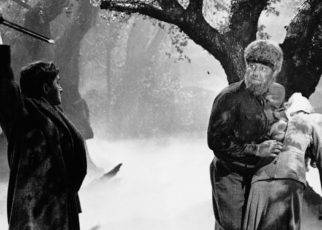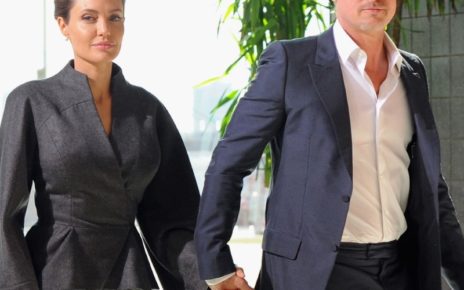After a death in the family, Larry Talbot (Lon Chaney) returns to his father’s estate to help continue their heritage. He soon becomes infatuated with one of the town locals, Gwen Conliffe (Evelyn Ankers) after some ‘innocent’ voyeurism.
When Larry and Gwen visit a fortune-teller called Bela (played, unsurprisingly, by Bela Lugosi), Gwen’s friend Jenny is attacked by a wolf. In an attempt to help, Larry succeeds in killing the wolf, but is himself wounded.
However, an investigation into what happened reveals that no wolf was killed that night, but rather the fortune-teller. Larry has already been told by several of the locals about the legend of werewolves and soon realizes that he is also now a monster.
The dead Bela’s mother, a gypsy woman by the name of Maleva (Maria Ouspenskaya), warns Larry of the curse, while his father (Claude Rains) remains unconvinced. But Larry is, indeed, a werewolf and soon embarks on nightly killing sprees.
Lon Chaney as the Wolf Man
Lon Chaney, Jr. (the Jr. was dropped from his name for this film) is disarming and charismatic from the start. He is immortalized here, helping to create the iconic Wolf Man which is now so ingrained in Western consciousness and would continue to play the role loyally throughout the sequels.
The design here was clearly to create a sympathetic and gentle-mannered character to contrast that of the murderous Wolf Man, marking Chaney’s monster as a tragic figure as opposed to Murnau’s repellant Nosferatu (many modern vampires and werewolves follow similar archetypes of the tragic monster seen here, though this film, of course, was not the first to portray it, with several incarnations of Quasimodo, Dr. Jekyl, Frankenstein’s monster, and the Phantom of the Opera all having preceded this film, including two previous werewolf-themed productions).
As well as Chaney plays his part, it’s impossible to hide the grand physique that would make him such an effective ‘monster-actor’ and in his scene with the diminutive Ouspenskaya, Chaney appears gigantic by comparison.
It could even be argued that because we rarely see the Wolf Man stood up straight, surrounded by other people, that Chaney is actually less imposing as the monster than he is without the make-up. Chaney’s unavoidable stature is smartly acknowledged in a moment’s discussion during the film, though at no point does anyone comment on the physical menace of the Wolf Man.
The Wolf Man Cast
Evelyn Ankers’ character is imbued with much of the 40’s ditzy ‘feminine weaknesses’, and is treated as such by the male characters (though there’s still been worse today). She nevertheless holds herself very respectably amongst the cast and would feature as a regular partner of Chaney and horror films, becoming known as ‘The Queen of Scream’.
There’s little required of Claude Rains’ part in the film beyond an austere patriarch and his career would be shaped by other projects (having been nominated for an award in 1939’s Mr. Smith Goes to Washington, Rains would also feature in high-profile films such as Casablanca in 1942 and, Lawrence of Arabia in 1962, amongst others).
Meanwhile, Maria Ouspenskaya is the quintessential gypsy woman and Bela Lugosi’s cameo is so incredibly melodramatic that you wish more films could be made like this.
Director George Waggner
Waggner had earned previous recognition in the horror genre for his Invisible Man (1933), and though he would produce the Wolf Man sequel, Frankenstein meets the wolf man, he would not be director. Nor would he be associated with any of the latter three sequels (for a fuller account of these sequels and other classic horror films, refer to the very-much-in-progress series of articles on Supernatural Horror in Films).
Waggner may be best known for his 1949 film featuring John Wayne, The Fighting Kentuckian, though his contribution here is surely more valuable to its respective genre.
The Wolf Man Summary
Naturally, the imperfections of the era can’t be attributed to bad production, directing, acting, writing or whatever.
Sure, these oldies can be hard to take seriously for today’s audience (the Wolf Man is foiled at one stage by a bear-trap and ultimately cannot overpower an older man with a walking stick), and it’s by no means a masterpiece of even it’s own era, but it was a great success and if you’ve seen it, you’ll know you’ve seen a classic. All helped, of course, by Jack Pierce’s famous look for the Wolf Man.
The vastly over-dramatized acting , the void of rural atmosphere and evidence of the close sets (endemic to most films in the 40’s) along with the ‘special’ effects makes it all so antique that this film and others like it can be loved purely on a historical and cultural basis.
In other regards, we can see that films haven’t come as far as we think, because conceptually this film has been re-made a thousand times in the decades since, across a variety of genres (often in homage, just as often not). For the most part, only the methods in which that concept is presented have actually become more sophisticated.
And speaking of re-makes…
The Wolf Man Re-make Starring Benicio Del Toro
In April 2009, Universal Pictures are releasing a re-make of this classic, starring Benicio Del Toro as Larry Talbot, Emily Blunt as Gwen Conliffe, Anthony Hopkins as father Talbot and Hugo Weaving as Inspector Aberline.
With a lengthy 67 years between them, this is not like re-making The Thing or the host of other projects receiving the ‘Pimp my X’ treatment. It may just be something special.
Expect updates on this site and a full review when it happens.
Producer: George Waggner
Director: George Waggner
Screenplay: Curt Siodmak
Starring: Lon Chaney, Evelyn Ankers, Claude Rains, Maria Ouspenskaya, Bela Lugosi
Released: December 1941 by Universal Pictures
Running time: 70 min




